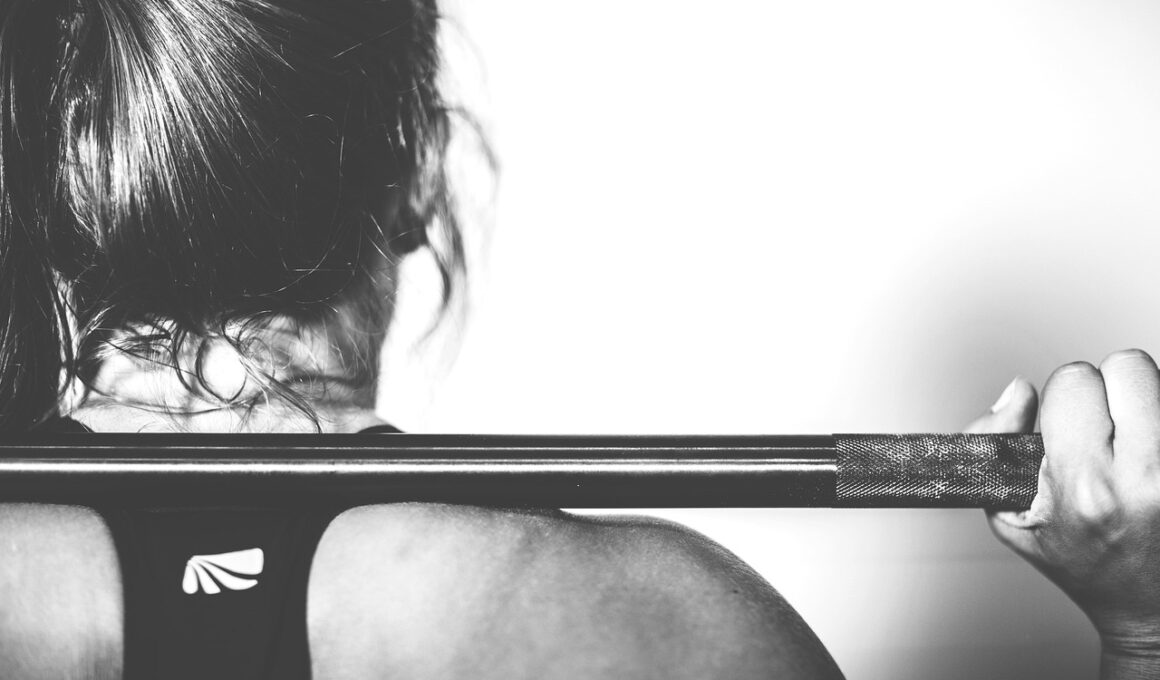Integrating High-Intensity Core Exercises into CrossFit Routines
High-intensity core workouts play a crucial role in enhancing overall stability and strength in CrossFit routines. CrossFit athletes often seek efficient methods to improve their performance, and incorporating high-intensity core exercises into training can yield remarkable results. Exercises like kettlebell swings, hanging leg raises, and plank variations challenge both strength and endurance, boosting an athlete’s core engagement. Moreover, a strong core can improve performance in Olympic lifts and help prevent injuries. By ensuring proper form and technique, athletes can maximize the benefits of these movements, enhancing their workout effectiveness. Integrating these exercises does not need to be overwhelming. Start by creating a structured routine that balances core training with other CrossFit elements. Remember that consistency is key in achieving the desired results. To properly gauge intensity, consider tracking the number of repetitions or weight lifted. Adjust your regime as needed to avoid plateauing. The goal is to keep challenging the core through progressive overload while ensuring adequate recovery and nutrition. Achieving high performance involves a calculated approach, so be patient as you work towards your fitness goals.
High-intensity core workouts provide numerous benefits that contribute substantially to CrossFit performance. These workouts enhance not only core strength but also stability, balance, and overall athleticism. A well-conditioned core supports proper posture and alignment, which is vital for executing complex movements. As athletes engage in various high-intensity modalities, their core must stabilize the body to prevent injuries. Many CrossFit athletes find that integrating high-intensity core exercises such as medicine ball slams and burpees helps maintain muscular endurance and endurance. This not only builds strength but also ensures the athlete can sustain performance across workout rounds. Additionally, engaging in varied core workouts, including rotational and anti-rotational movements, helps simulate demands faced in other CrossFit activities and sports. Furthermore, consistent performance in core workouts translates to improved scores in WODs (Workout of the Day). Incorporating exercises targeting different muscle groups, such as the obliques and lower back, ensures balanced development. Athletes should not discount the psychological strength gained from facing and overcoming the challenge of high-intensity workouts. This grit can carry over into other workouts and life challenges, reinforcing the importance of core training.
High-Intensity Exercise Techniques for the Core
When it comes to high-intensity core exercises, utilizing proper techniques is paramount for gaining the most benefit. Start by considering functional movements that mimic real-world actions, such as deadlifts or Olympic lifts. Use compound movements to engage multiple muscle groups while providing a robust core workout. High-intensity interval training (HIIT) can add incredible benefits when incorporated into core routines as athletes can push their limits during short bursts of exercise. Adding kettlebell swings, for instance, not only targets the core but promotes hip mobility and explosiveness, two critical factors for CrossFit athletes. Another example includes the use of stability balls, which force the core muscles to stabilize and engage throughout the exercise. Engaging in partner workouts can intensify training, adding to the competitive spirit commonly found in CrossFit. Experimenting with sudden changes in pace can add excitement and a greater challenge, keeping workouts fresh and dynamic. Always remember to warm up properly to prevent injuries, and take the time to cool down and stretch afterward, as maintaining flexibility is essential for core health and recovery. Emphasizing quality over quantity will maximize the advantages gained from your workouts.
Moreover, integrating high-intensity core workouts into standard CrossFit sessions can foster a sense of community and camaraderie among participants. Group workouts encourage accountability and motivation as athletes push each other to reach their limits and celebrate each other’s successes. Incorporating team challenges or partner workouts centered on core exercises elevates the experience, making it enjoyable and effective. Swinging a medicine ball back and forth during a core drill can strengthen teamwork, as well as build individual resolve. The benefits of group training extend beyond physical prowess; these sessions provide significant social support, which can bolster mental determination. This mental aspect is often overlooked but is vital for long-term athletic commitment. Furthermore, high-intensity workouts can break the monotony of traditional training, sparking a renewed interest in core workouts. Ensuring a varied workout regime also allows for a well-rounded approach and avoids injury. As athletes challenge their core, they experience improved fitness levels, and enhanced metabolic effects. The importance of community and mutual encouragement cannot be underestimated. Enjoy the journey, embrace the challenges, and take pride in every achievement, no matter how small.
Incorporating Nutrition with Core Workouts
Nourishing the body is just as vital as implementing high-intensity core workouts in enhancing CrossFit performance. Understanding the connection between nutrition and exercise is crucial. Proper nutritional support helps fuel workouts and facilitates muscle recovery. Consuming nutrient-dense foods before workouts maximizes energy levels and supports endurance. Complex carbohydrates, healthy fats, and high-quality proteins should form the basis of any athlete’s diet. For instance, incorporating whole grains, lean meats, and plenty of fruits and vegetables can provide essential vitamins and minerals. Post-workout nutrition is equally critical; consuming a balanced meal rich in protein can enhance muscle repair. Consider things like protein shakes, eggs, or Greek yogurt after workouts to kickstart recovery. Hydration cannot be overlooked, either. Drink plenty of water to maintain peak performance levels, especially when engaged in high-intensity training. This facilitates overall health and performance. Staying consistent with both nutrition and intense core workouts can lead to noticeable improvements over time. It’s important to listen to your body, adjust nutrition accordingly, and adapt training plans based on individual needs. Active recovery days, including appropriate nutrition, can keep athletes on track towards optimal performance.
Finally, assessing progress through regular testing and evaluation can help determine the effectiveness of integrating high-intensity core exercises into CrossFit routines. Setting specific performance markers provides tangible goals to work towards. These can vary across different fitness areas, such as increased repetition of an exercise or enhanced time for completing a workout. Regular assessments allow athletes to recognize growth and areas needing additional focus. Consider scheduling progress tests quarterly to maintain objective evaluations. Incorporate mixed-method assessments, like timed rounds of core-focused workouts or even max repetitions. Data collected during these evaluations inform training strategies, allowing for necessary adjustments to the core workout routine. Maintaining a training log can also facilitate this process, recording metrics, subjective feelings, and workouts. Engaging with a community of peers or coaches can keep individuals accountable for their training. Sharing goals and achievements can create motivation and promote continual improvement. In summary, integrate high-intensity core workouts into CrossFit routines for a comprehensive approach. It empowers individuals to elevate their performance and engage their core strength effectively while fostering community and accountability. The journey to better fitness is continual and rewarding.
In conclusion, the integration of high-intensity core exercises into CrossFit routines serves as a cornerstone for developing both strength and stability. Pursuing these workouts can enhance overall athletic performance, prevent injuries, and improve quality of life. As athletes implement these principles into their regimen, they will discover the countless advantages reaped from consistent core training. The results are seen in not just physical gains but also improved mental resilience, fostering a sense of accomplishment and discipline. Regularly challenging the core through varied movements keeps the training fresh and engaging. Remember that every effort counts, even small improvements, leading to the ultimate goal: a stronger, healthier body. It is essential to embrace the process, fueling both body and mind through a balanced nutritional approach and supportive community. Engaging in partner workouts or competitive exercises can create stronger connections amongst athletes in the CrossFit community, encouraging growth in accountability and intensity. The path is not without challenges, but it is gratifying. By committing to high-intensity core workouts, athletes position themselves for greater success in tackling the rigorous demands of CrossFit and achieving personal fitness milestones.


